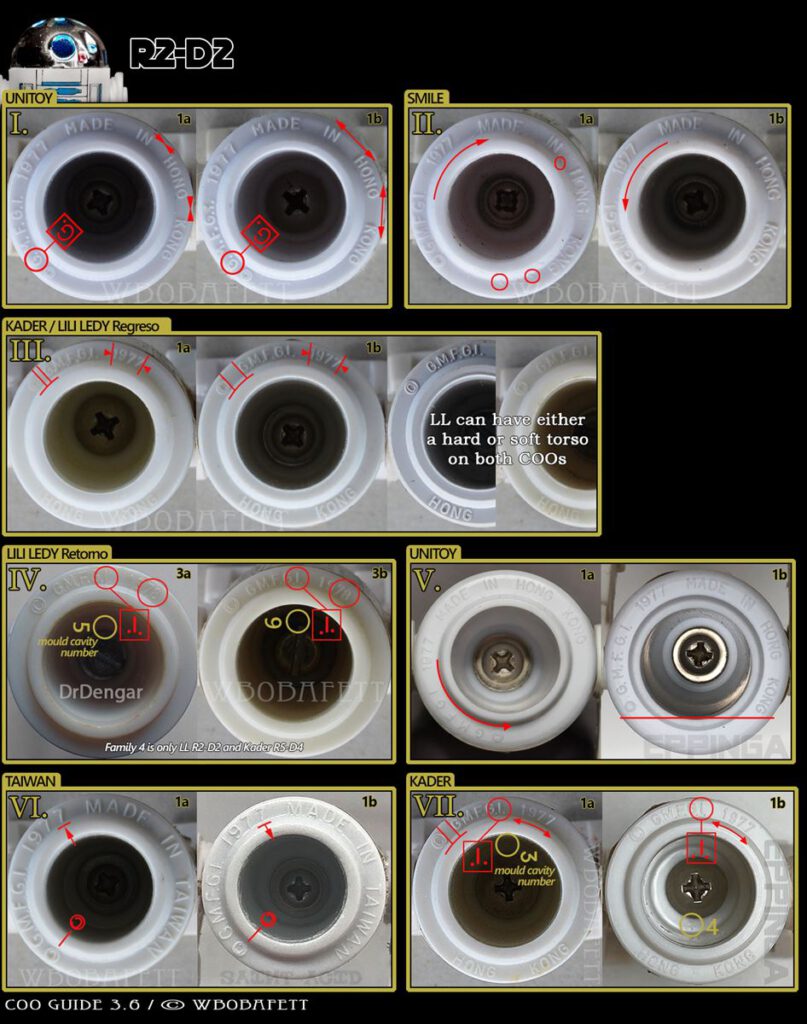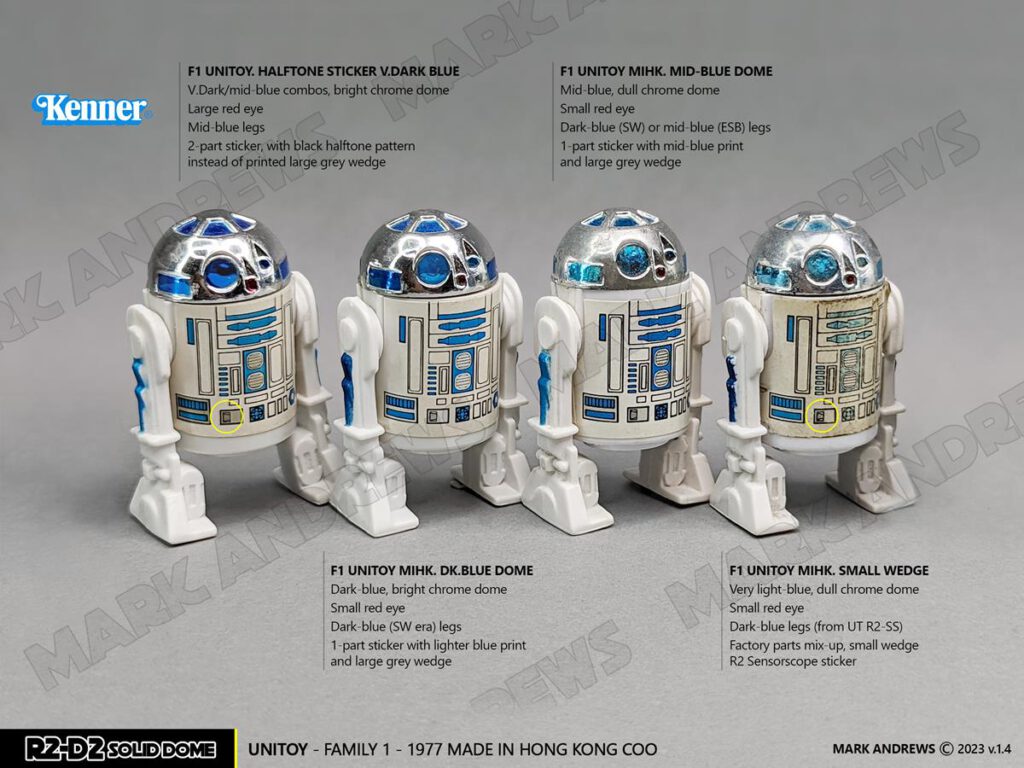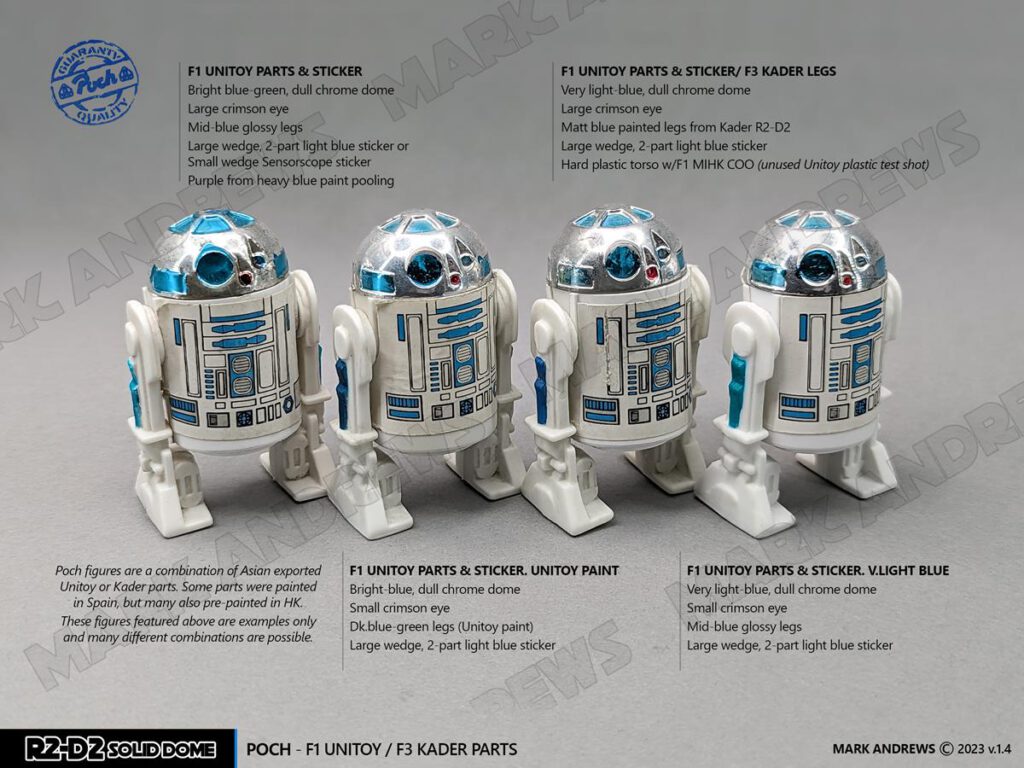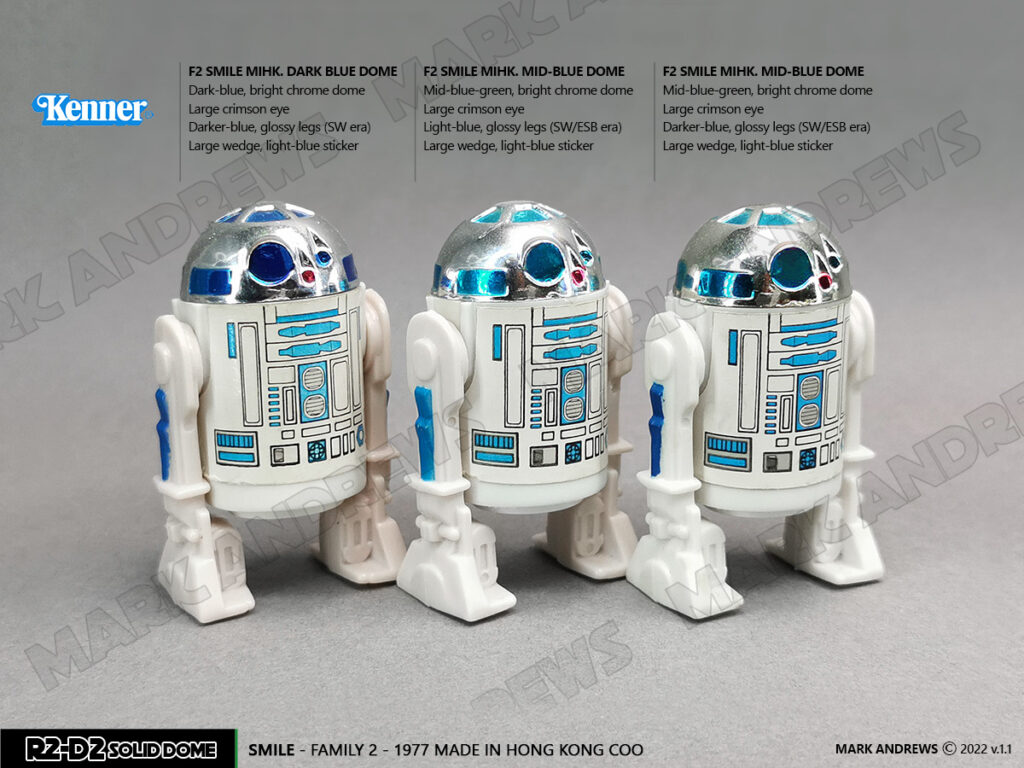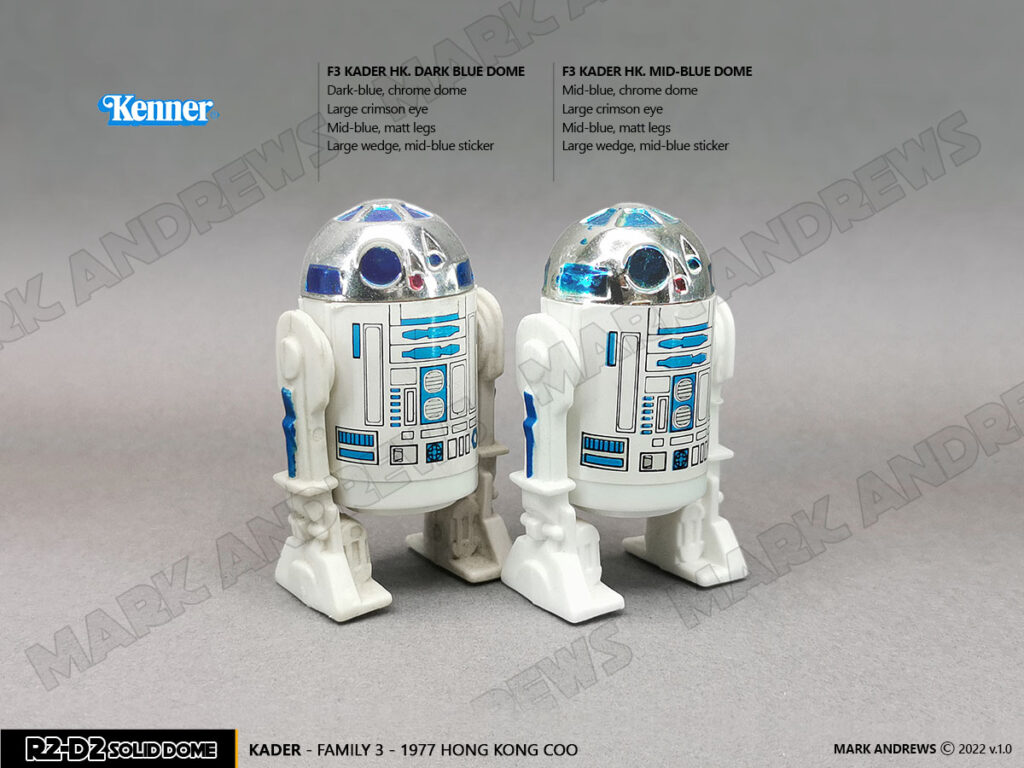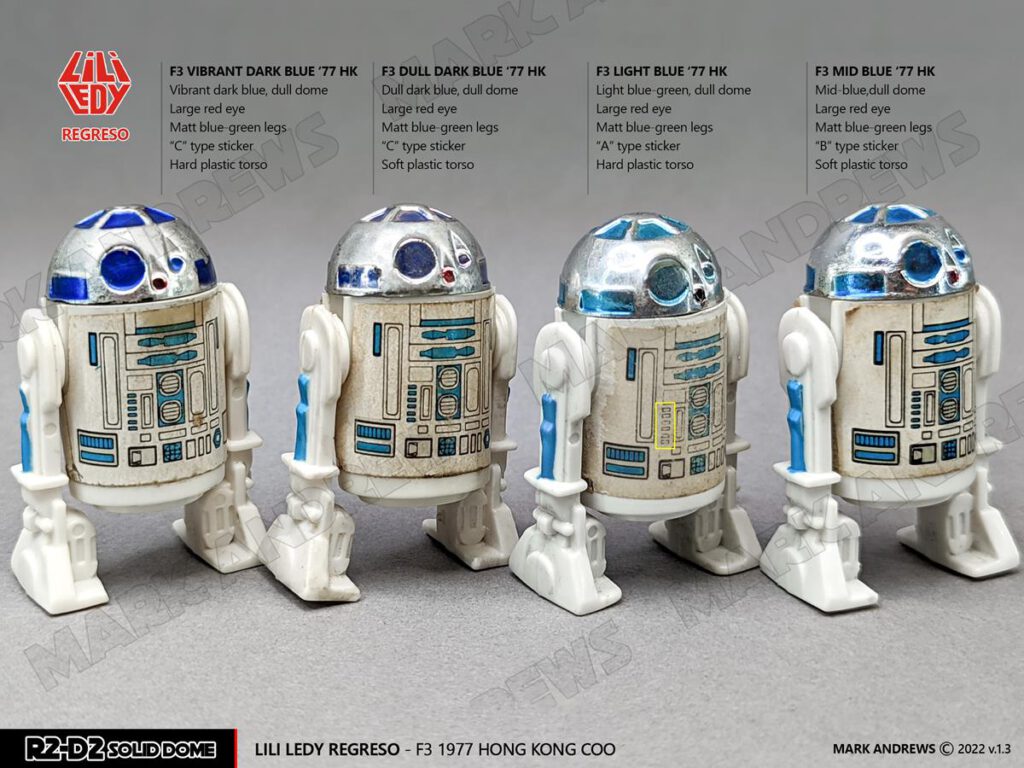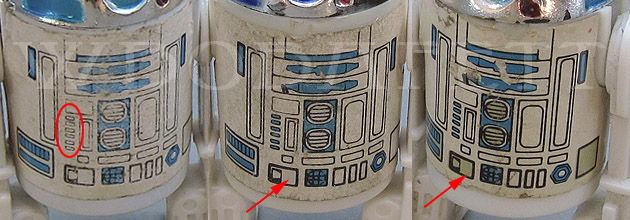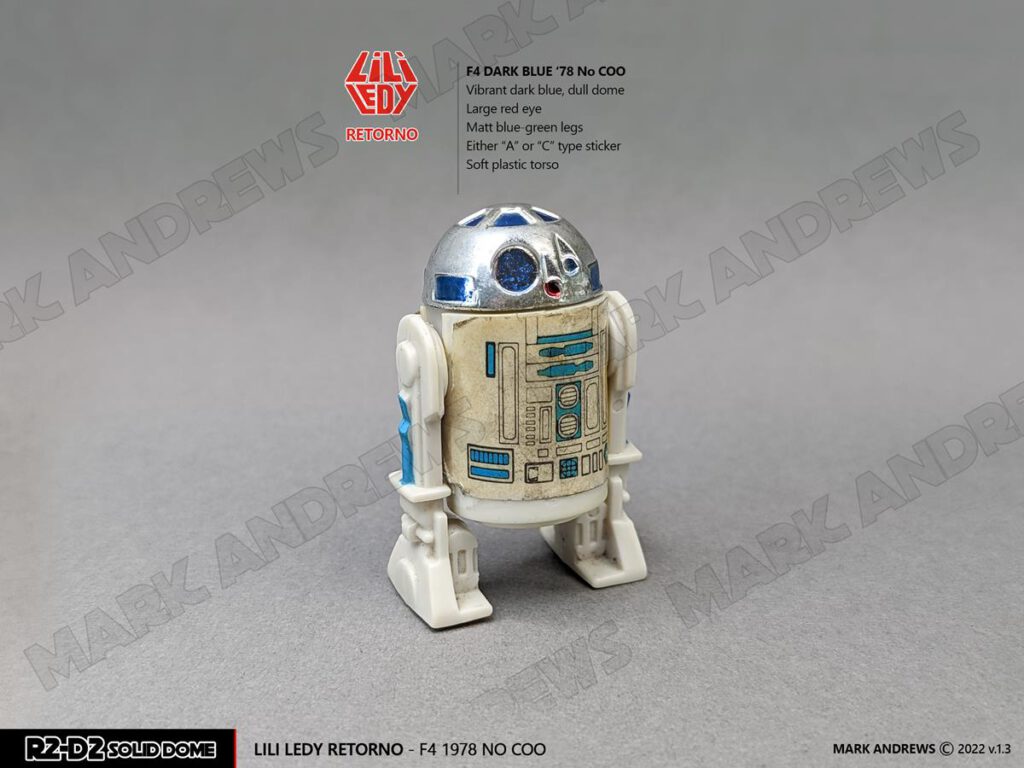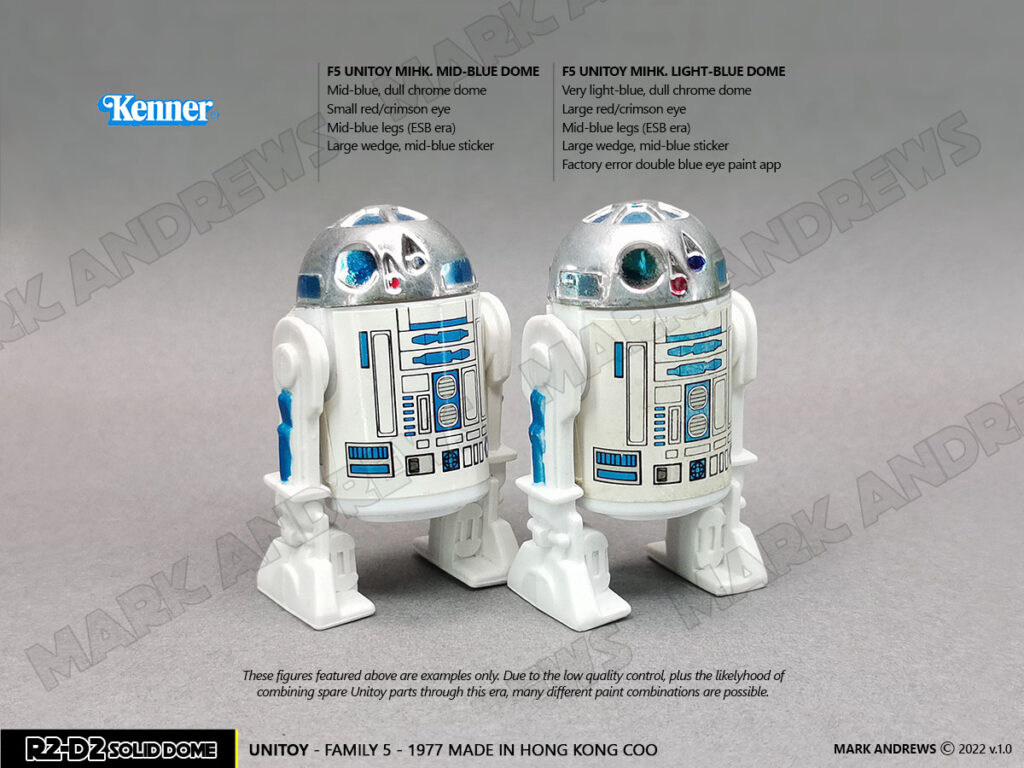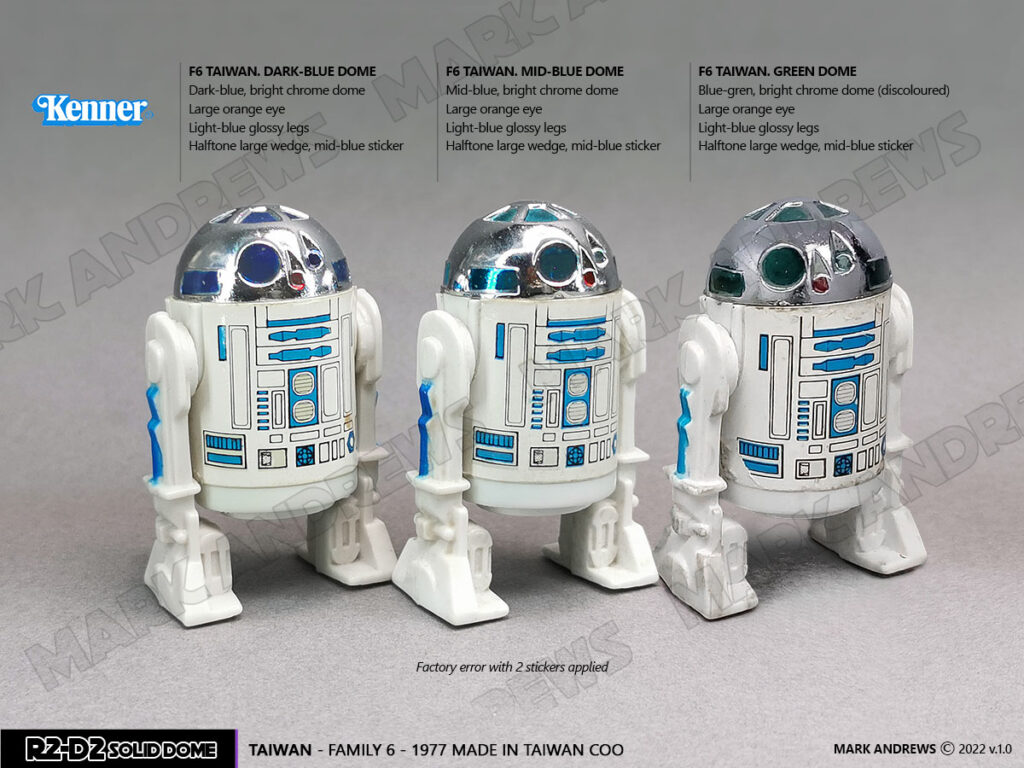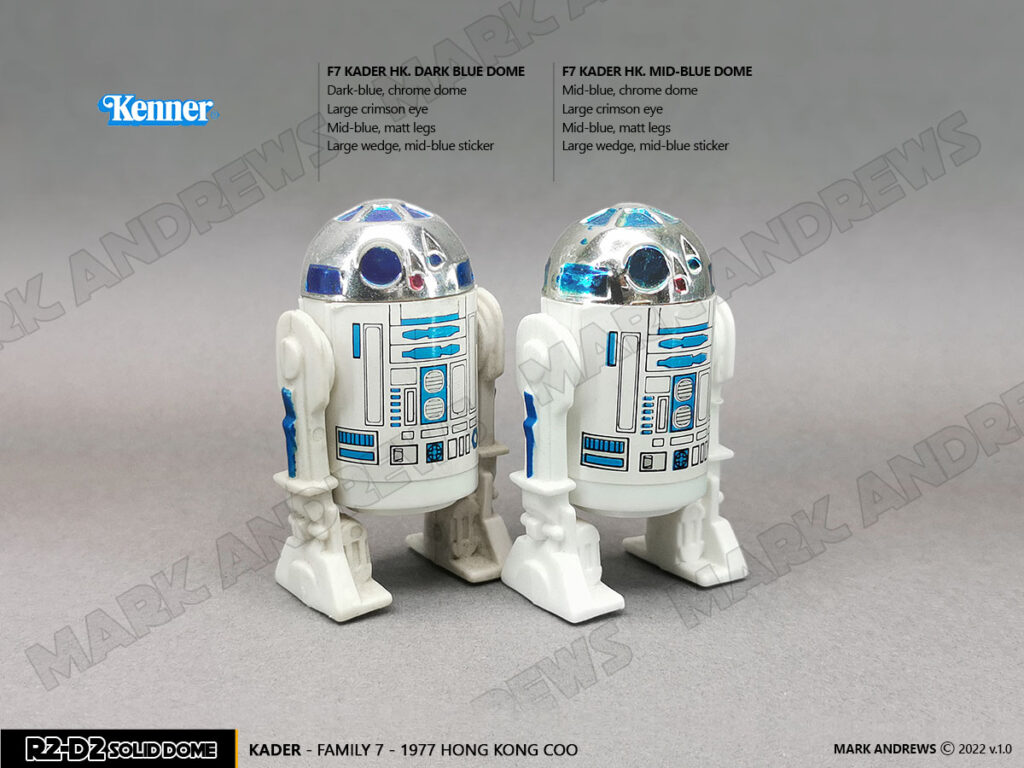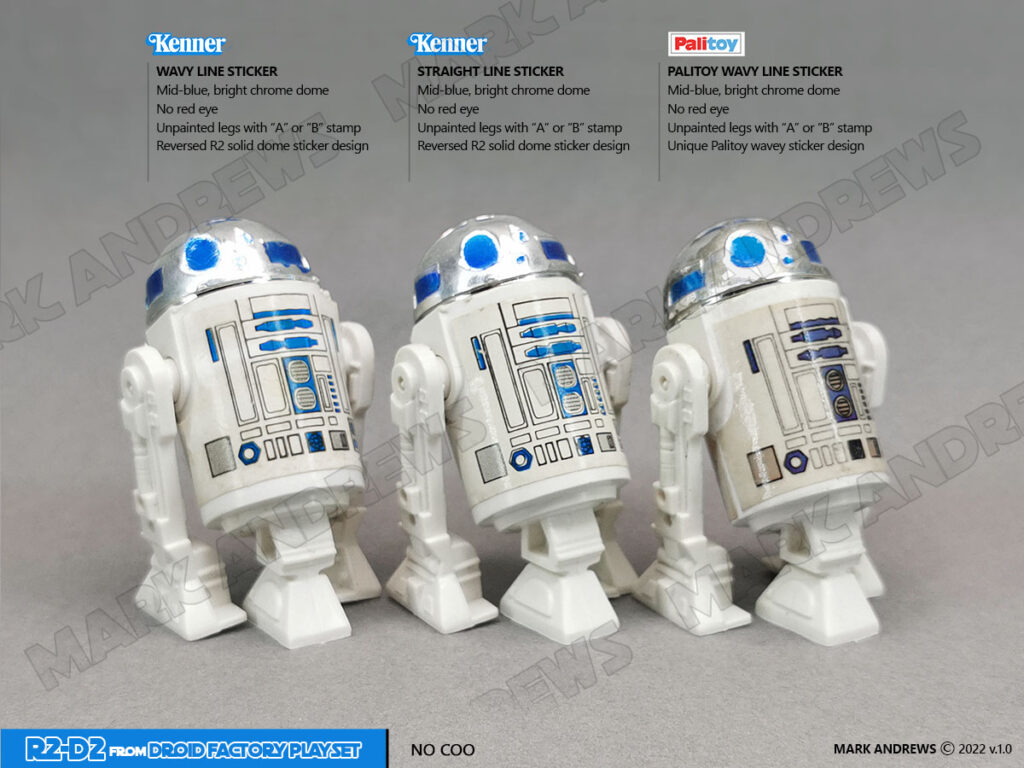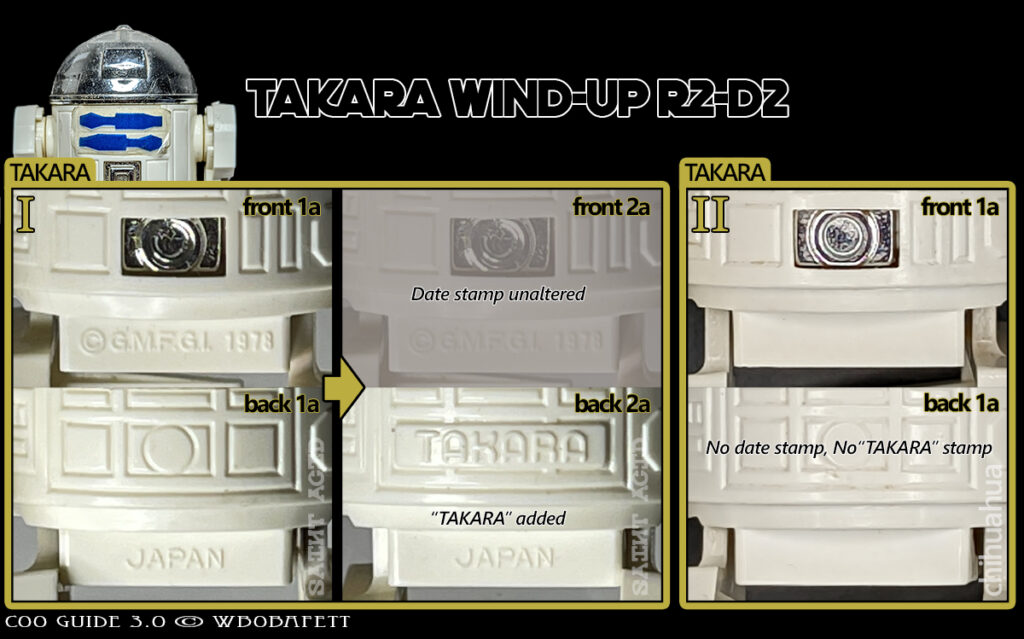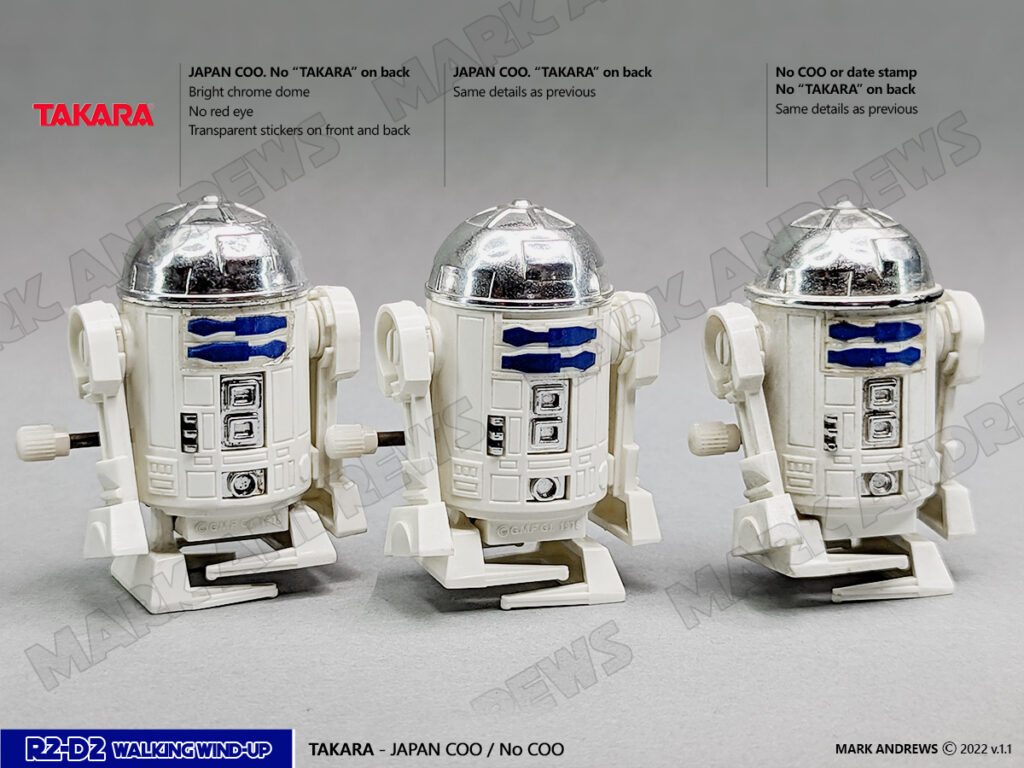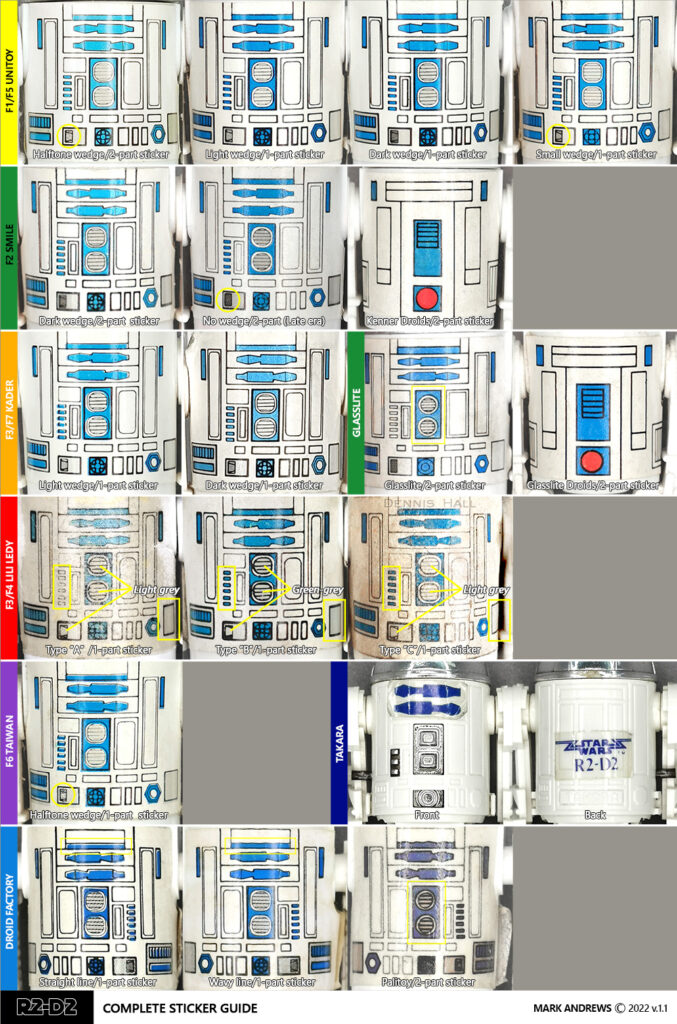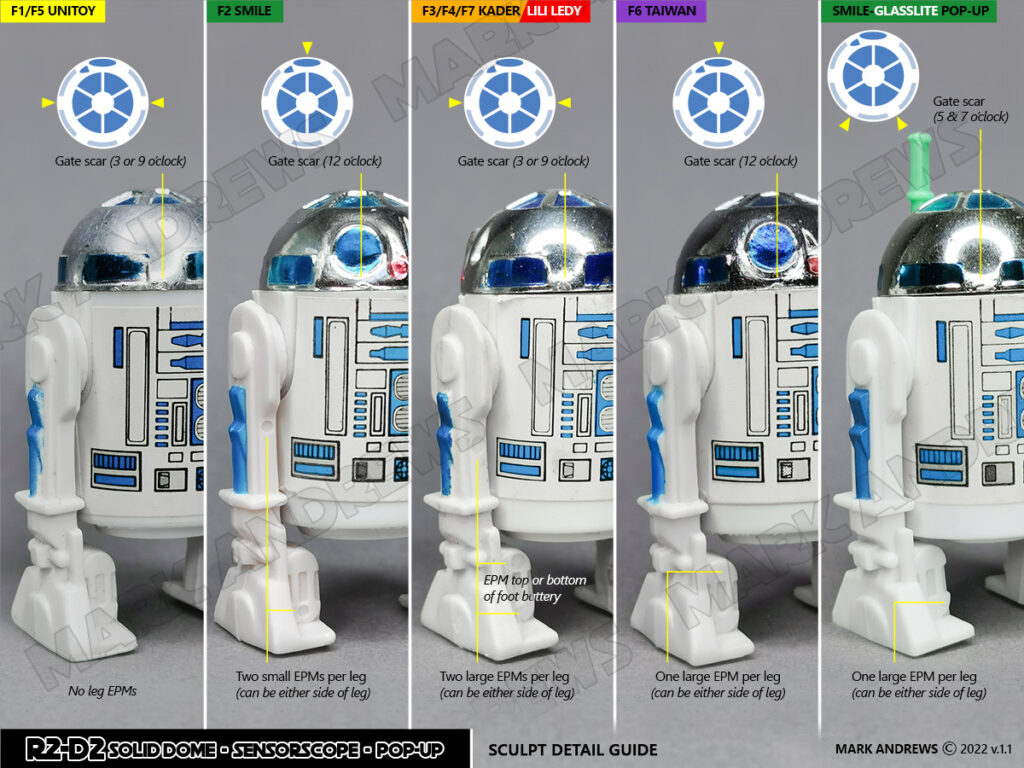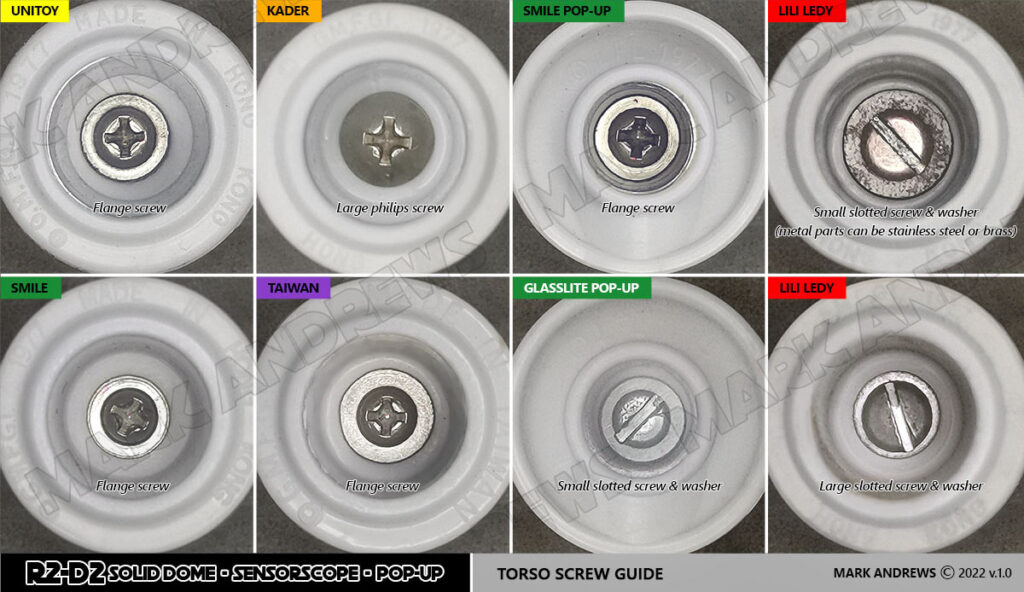R2-D2
UNITOY with their typically low QC produced the widest variety of Kenner R2 paint variations from a single source. The trend is that their earliest figures, which can be found in “Early Bird” kits or on 12a/b/c backs, feature the dark blue domes and soon evolve to mid blue for the remainder of their run.
Above you can see following variants (left to right):
- Very dark-blue w/halftone sticker (Early bird era)
2-part sticker variant, which has a halftone pattern in the wedge area. This very early Unitoy figure is found with mid-blue legs.
- Dark-blue dome (SW era)
The next version of the dark blue dome R2 has a one part sticker and revised artwork with no halftone pattern. I can only guess it was an early production decision to streamline the process down to a single sticker.
- Mid-blue dome (ESB era)
A last proper Unitoy release is the solid dome ESB era 41bk figure, with mid blue domes and mid-blue legs. This is where I’ve found the rarer, mould family 5 R2-D2 figure, which exists for no reason I can discern.
- Small wedge sticker (Transition from solid dome to Sensorscope)
The “small wedge” figure features the updated Unitoy Sensorscope sticker on a standard solid dome R2. The legs are also the darker blue which returned for the Sensorscope R2 figure.
- Edit 23/05/23: Suspected Meccano exclusive moved and relabelled to “Very light blue dome” in the Poch section below.
POCH figures are a combination of Asian exported Unitoy or Kader parts from the late ESB era. Some parts were painted in Spain, but many also pre-painted in Hong Kong. These figures featured above are examples only and many different combinations are possible.
Poch R2s can sometimes have the smaller wedge Sensorscope sticker as the two figures were produced in the same era. Darker splotches of paint are a result of heavy paint pooling around the edge of the dome spray mask.
Above you can see following variants (left to right):
- Typical Poch R2-D2
This figure is characterised by a bright blue, but dull chrome dome, a crimson-red eye (not necessarily small) which can appear purple if there’s pooled paint. The legs are a glossy mid-blue and can sometimes have a mist/splattery appearance to the paint application.
- Mixed-up Poch w/Unitoy leg paint
Same features as example (A), but with dark blue-green (Kenner?) legs which is close to what can be found on the early Unitoy R2 figures. I haven’t yet found a Kenner R2 with this exact leg paint colour, but feels unlikely to be Poch either.
- Mixed-up Poch & Unitoy/Kader parts & paint
This figure is an odd one. It has a typical Poch dome, typical Kader painted legs (commonly found on Poch R2s), however the torso is shot in a harder plastic than the typical Unitoy R2. I speculate this could be a plastic test shot from the Unitoy factory that just happened to be sent to Spain. Under magnification and UV, the plastic doesn’t match other PBP, Lili Ledy or Kenner hard plastics.
Very light blue dome
In the late Jedi era, solid dome R2’s re-appear on MECCANO 65bk and French Trilogo cardbacks. These MIHK COO figures have similar traits to earlier Poch R2-D2s and the late ESB Unitoy figures, with their small red eye, very light blue dull dome and mid-blue legs.I’ve struggled how best to categorize this figure. After much thought, I feel these R2’s fit in with a pattern of higher quality Poch figures turning up in European countries outside of Spain (France in this case). The timeline is peculiar as only the No COO Sensorscope R2 was in production in this late era, but given the traits previously mentioned, I feel it’s best to consider this R2 as Spanish assembled and painted by Poch/PBP.
To identify an R2 confidently as Poch requires more of a combination of certain traits. I’ve seen Unitoy figures with plastic burrs, messy paint, lighter blue legs, paint overspray, light blue dull chrome domes and small/large crimson eyes – which have been the most commonly used Poch tells in the past.
SMILE R2 has a dark blue dome from the outset, which was changed in the 12bk era to an electric mid-blue dome colour. Smile R2s consistently have a large crimson eye. The legs have minor mid-blue variations, but this colour scheme remains consistent through Smile’s entire solid dome run, through the Sensorscope era, and finishing with the Pop-Up R2.
Above you can see following variants (left to right):
- Dark blue dome (early SW era)
The first version has a dark blue dome and glossy darker-blue legs.
- Mid-blue dome (SW era)
This SW-era figure transitions to a lighter “electric” blue dome. The legs are a slightly lighter shade. The sticker grey becomes incrementally darker.
- Mid-blue dome (ESB era)
Same as mid-blue SW era, but the legs return to a darker shade. The sticker evolves again and the wedge is very nearly gone.
KADER was arguably the largest producer of solid dome R2-D2s. Their earliest dark blue figure was commonly featured in “Early Bird” sets and 12bk era cardbacks. The Kenner directive applied here too and thus the mid-blue dome & leg figures started to appear in the 12bk era and remained their main version till the end of Kader R2 production on the 32bk card.
Above you can see following variants (left to right):
- Dark blue dome (early SW era)
The first version has a dark blue dome, large crimson-red eye and matt, mid-blue legs.
- Mid-blue dome (SW & ESB era)
This figure transitions to a lighter mid-blue dome. The legs remain the same matt, mid-blue throughout the Kader line.
August 2022 we realized the previous group of (4x) Family 3 COOs were actually two COO family pairs. Previous COO F3-a/c are the true family 3 and previous F3-1b/d are now the new Kader mould family 7.
POCH were supplied Asian produced Kader parts to build some of their R2 figures. See above in the Unitoy Family I section for more information.
The LILI LEDY 1977 R2 has a variety of dome colours, however the light-blue leg remained consistent across their line. LL’s sticker is a unique artwork that was produced in Mexico. Refer to the sticker guide for details on the A, B & C type LL stickers.
Above you can see following variants (left to right):
- REGRESO 1977 HK Vibrant dark-blue dome
An eye-catching vibrant darker-blue dome. A or C type LL sticker.
- REGRESO 1977 HK Dull dark-blue dome
I’ve seen this called a transition figure, however the dome colour has a purple-ish hue to the blue compared to the Retorno version. Refer to the F4 1978 Retorno figure below. A or C type LL sticker.
- REGRESO 1977 HK Light-blue dome
Light blue dome, with a greenish hue. A or C type LL sticker.
- REGRESO 1977 HK Mid-blue dome (PBP exclusive?)
Same as previous, except features the B-type LL sticker. The PBP released R2 is a Lili Ledy made figure which was imported from Mexico and carded in Spain. Very few MOCs have survived, but it seems those surviving feature the LL “B-type” sticker. This suggests the B-type sticker MIGHT be exclusive to the PBP released Lili Ledy R2. This is most likely to be a print batch which just happened to have a more greenish hue to the grey instead of the neutral light-grey found on the “C-type” sticker.
Image and text credit: Wolff Lipinsky. This picture shows a comparison of all three LL sticker variants. First is the one with the missing blue paint (see the red circle). The second one has really light grey areas (see arrow). The picture doesn’t show this very well, but they are indeed grey, not white. Last one is the sticker variant with the greenish grey areas printed on.
The LILI LEDY R2 sticker is a unique artwork that was produced and utilized solely in Mexico. Refer to the sticker guide for details on the A, B & C type LL stickers.
Above you can see following variant:
- RETORNO 1978 NCOO Vibrant dark-blue dome
This version has a dull, dark-blue dome, large crimson eye and Lili Ledy’s trademark glossy, light -blue legs. The sticker here is the “A” type with no small blue boxes and very light grey panels, though could also legitimately be the “C” type.
Lili Ledy received the R5-D4 No COO 78 torso mould from Kader in Hong Kong to produce their ESB era “Retorno” R2-D2 figure. The COO removal is thought to be done by Kader in the early Jedi era. After a short period in Mexico, the moulds were returned to Asia and the next time this torso appears, it is reunited with the R5-D4 figure on the very late era French Trilogo Meccano cards and Meccano baggies.
This UNITOY solid dome I have only found in the ESB era 41bk figure. It features mid/light-blue domes and mid/light-blue legs. This is where I’ve found the rarer, mould family 5 R2-D2 figure, which exists for no reason I can discern. Perhaps this torso was intended for R5 and they had spares leftover to utilize. These F5 Solid dome figures are poorly made and commonly feature loose domes/joints, messy paint, and very little colour consistency. Looking in overview, we know in the 45bk era was where a great number of legacy characters were re-assigned to factories elsewhere and it feels as if these F5 R2’s were assembled quickly to clear out older stock and free up warehouse storage.
Above you can see following variants (left to right):
- Mid-blue dome
Dull dome. Very small red eye. Gaps around the underside of the dome. Mid-blue ESB era legs.
- Light-blue/green dome (ESB era)
Dull dome. Larger crimson eye. Double blue paint application on the eye. Gaps around the underside of the dome. Mid-blue ESB era legs.
These figures featured above are examples only. Due to the low quality control, plus the likelihood of using up spare parts, different paint colours & combinations are possible.
TAIWAN R2-D2 was a 12 back figure only. As with the other lines, Taiwan debuts with a dark blue dome. Despite the high quality manufacturing in the Taiwan figure line, their spray booth operation across all figures had little regard for consistency, and as a result, there’s 2 or 3 shades of mid to green-blue on their domes. Taiwan R2 features a three-colour sticker with a halftone (grid) pattern on the wedge.
Above you can see following variants (left to right):
- Dark-blue dome
Large orange-red eye. Light-blue legs.
- Mid-blue dome
Large orange-red eye. Light-blue legs.
- Green-blue dome
Large orange-red eye. Light-blue legs.
KADER produced HK stamped figures from two moulds in tandem. These moulds share such similarities it’s thought they were produced at similar times. These two COOs were previously known as 3-1b/d until we realized they belonged to a new mould family. Overall sculpt is seemingly identical, but an emerging pattern of SW era cavity pairs, some minor font variations and the fact that only (ex-) F3-1a/c were found on the Lili Ledy figures prompted us to look closer and realize there was a new Kader mould family 7 to classify.
The paint details, sculpt and sticker remains the same as the family 3 Kader figures.
Above you can see following variants (left to right):
- Dark blue dome (early SW era)
The first version has a dark blue dome, large crimson-red eye and matt, mid-blue legs.
- Mid-blue dome (SW & ESB era)
This figure transitions to a lighter mid-blue dome. The legs remain the same matt, mid-blue throughout the Kader line.
This figure is part of the Droid Factory playset Kenner released in 1979. Many collectors choose to have this figure included in their loose figure run, so I’ll include here in this guide. There’s no shared parts between the droid factory and the solid dome R2. This Droid Factory version is a unique sculpt, which includes a removable third leg and is designed to be completely disassembled. The sticker is also different to the standard R2 in that the artwork was drafted in reverse. There’s minor sub-variations of the Droid factory sticker with a straight or wavy line in the top-centre. Palitoy drew their Droid Factory sticker art differently again to the US released Kenner version.
Above you can see following variants (left to right):
- Kenner: Wavy Line Sticker
The top, central blue rectangle has a wavy top.
- Kenner: Straight Line Sticker
The top, central blue rectangle has a straight top.
- Palitoy: Wavy Line Sticker
Unique sticker. The top central blue rectangle has a very wavy top.
This figure isn’t part of the Kenner line, but as with above, some collectors choose to include it as part of their collection.
The Takara wind-up R2 was released in 1978 in a baggie with a JAPAN COO. The “Takara” stamp was later added to the torso rear. These were also released on a bi-lingual (French/English) language cardback in Canada.
A second mould family for this figure is documented above with some notable differences, including a larger dome and some chrome buttons mould variations.
Above you can see following variants (left to right):
- Family 1-1: Japan COO without Takara stamp
Smaller dome rim. Larger chrome buttons. Mid-blue sticker.
- Family 1-2: Japan COO with Takara stamp
Smaller dome rim. Larger chrome buttons. Dark-blue sticker.
- Family 2: No COO, and no Takara stamp
Larger dome rim. Smaller chrome buttons. Dark-blue sticker.
The standard solid dome R2-D2 sticker is a 3 spot-colour print with blue, black and grey.
The first UNITOY version was a 2-part sticker and featured a halftone pattern in the black colour separation. This was quickly changed to a 1-part sticker featuring no halftone pattern. Don’t confuse this sticker with the Taiwan version which also has a halftone pattern on the wedge. This must have been an early production decision to streamline the process from applying two stickers, down to just one. (Having said that, other factories retained the two stickers through the whole run).
Subsequent Unitoy stickers were a single application. They progressively printed in a darker shades of grey. These are the versions that were predominantly used for the POCH version of R2-D2. Some Poch R2’s can be found with the “small wedge” Sensorscope sticker.
For the Unitoy R2-D2 Sensorscope figure, the black separation on the sticker is altered to feature a smaller “wedge” design. Similar to R5-D4, some solid dome R2’s were also shipped with this small wedge sticker in the transition period between the two versions of R2.
The SMILE R2 sticker has a darker “wedge”. The grey progressively becomes darker from their initial dark blue dome figure through to the Pop-up version. There’s a subtle revision of the sticker artwork in the Jedi era.
KADER R2’s had a limited run in the SW and early ESB eras. In that relatively short span there’s no major sticker designs variations, however the grey wedge darkens in their last wave, the 32bk period.
The TAIWAN R2-D2 sticker uses a halftone pattern over the wedge to represent a darker grey effect.
LILI LEDY created their own unique sticker design. The artwork layout is the same across all LL stickers. There’s two main versions: One with blank rectangles (Type-A), and the others with blue rectangles, plus either green-grey (Type B), or light-grey shades (Type C) in the other panels. The paper stock used for the Ledy sticker was a low grade matt type, and being very porous resulted in extremely poor durability from playwear and age.
The PBP released R2 is an Lili Ledy made figure which was imported and carded in Spain. Very few MOCs have survived, but it seems those surviving feature the LL “B-type” sticker. This suggests the B-type sticker may possibly be exclusive to the PBP released iteration of the Lili Ledy R2. This is most likely to be a separate print batch which happened to have a greenish hue to the grey paint instead of the light grey found on the other “C-type” sticker. It seems that the paper stock used for this version was of a more durable quality with a glossy finish to the surface.
GLASSLITE used a sticker artwork based on the Kenner art, but is in fact unique to their factory. This applies to both their regular Pop-up R2 as well as their Droids version. Both are subtly different to the Kenner versions.
TAKARA released all three of their Wind-up walking R2 figures with a transparent plastic sticker on the front and back. Some stickers have the “TM” after R2-D2 and some are without. Both text variations are found on all 3 wind-up versions.
The DROID FACTORY PLAYSET was issued with a sticker sheet that included the decal for the R2 figure. The sticker is different to the standard R2 in that the artwork design was printed in reverse. There’s minor sub-variations of the Droid factory sticker with a straight or wavy line top-centre. Palitoy drafted their Droids Factory sticker art differently again to the US released Kenner version.
REPRO stickers have been in circulation for decades now, and the most recent versions have even been designed to artificially mimic the yellowing effect of the ageing process. In the making of this guide, I saw dozens of figures sold on eBay as vintage, priced as vintage, but in actuality had reproduction stickers applied purely to dupe unsuspecting buyers.
With all figures, each part and accessory is specific to a factory. This is no different with R2-D2, as every part, screw and sticker used to produce the figure also being specific to a particular vendor.
EPMs and gate scars are the most effective way of confirming the origins of R2 parts. For more information about what these terms mean, please refer to my 101 REFERENCE GUIDE.
Parts can easily be swapped around and for decades this has been done, and done incorrectly. If you have an R2 which has anything different to what’s shown here, I’d take a look at the other parts on the figure using my sculpt detail guide to see if the R2 has been tampered with. These Astromech figures have been messed around for decades by sellers/collectors looking for the cleanest example and indifferent/ignorant to the fact they’ve created a Frankenstein figure.
Just as an aside, this screw detail graphic also can apply to the Unitoy and Kader R5-D4 figure.
Some early Lili Ledy R2s can be found with brass screws/washers as an alternative to the stainless steel versions featured in my graphic.
